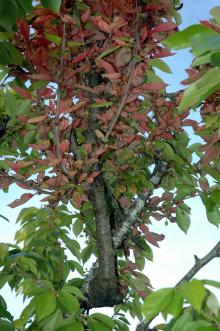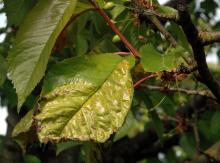See:
Peach (Prunus persica) - Leaf Curl
Cause Taphrina wiesneri, on cherry, T. confusa on Chokcherry, and T. flavorubra on Western Sand Cherry, fungi. Ascospores from diseased leaves fall on buds and, upon germinating, penetrate the branch, stimulating it to abnormal growth year after year. Once a branch is infected, it will always remain so, and the leaves on the "broom" will be diseased every year. In Oregon, the disease is only on sweet cherry trees.
Symptoms Large, broom-like tufts develop on branches. They are easily distinguished at blossom time: they have few flowers and become leafy earlier than normal branches. Brooms do not bear fruit. At the base of the witches' broom is a common stem, which may be much thicker than the branch to which it is attached. Long, slender branches grow from this stem. Affected leaves somewhat resemble peach leaves affected by peach leaf curl-thick, reddish, with a white growth of fungus (asci) on the undersurface.
Cultural control
- Prune out the witches' brooms. Trace the main stem of the "broom" to where it grows from the normal branch, then cut the branch at least 12 inches below that point.
Chemical control Make an application at delayed dormant growth stage.
- Rex Lime Sulfur Solution (28%) at 6 to 12 gal/100 gal water. 48-hr reentry. O
Reference Shoji, T., and Sato, K. 1980. Control of witches' broom on cherry trees caused by Taphrina wiesneri by pruning of the diseased twigs and fungicidal application. Annual Report of the Society of Plant Protection of North Japan 31: 95-97.



